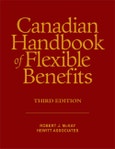Now in a new third edition, Canadian Handbook of Flexible Benefits offers everything organizations need to know about designing, implementing, communicating, and administering a successful flexible benefits program. The 2007 Handbook is equally relevant to employers introducing a new plan and to those looking for insight and direction on maintaining an existing program.
This edition answers the question "What s new in flex?" and includes up–to–date information on:
- the expansion in the range of flexible programs in the last decade, from simplified to total compensation designs;
- incorporating the numerous innovations in health care cost management into a flexible program;
- legal aspects of flexible benefits, including the latest word from Canada Revenue Agency on converting taxable performance bonuses to pretax benefits;
- administration alternatives, including outsourcing, co–sourcing and multi–process outsourcing;
- Completely new material covering:
- retiree flexible benefit programs,
- maintaining and revitalizing an existing plan
- flex for executives,
- special considerations for specific provinces,
- case studies of companies that have successfully implemented flexible benefits, and
- flexible benefit developments in eight countries on five continents.
Table of Contents
Foreword.Preface.
About the Editor.
Contributors.
PART ONE: OVERVIEW.
Chapter 1. Origins and Objectives.
Chapter 2. Elements of Flexible Benefits.
Chapter 3. Starting and Maintaining a Flexible Program.
Chapter 4. Plan Structure and Eligibility.
PART TWO: DESIGN.
Chapter 5. Health Care.
Chapter 6. Death and Disability.
Chapter 7. Flexible Accounts – Health Spending, Personal, and Perquisite.
Chapter 8. Time Off with Pay.
Chapter 9. Flexible Benefits for Retirees.
Chapter 10. Retirement.
Chapter 11. Emerging Benefits.
PART THREE: LEGAL AND REGULATORY ENVIRONMENT.
Chapter 12. Taxation of Flexible Benefits.
Chapter 13. Discriminating Issues.
PART FOUR: STRUCTURE AND FINANCING.
Chapter 14. Pricing.
Chapter 15. Financial Analysis.
Chapter 16. Adverse Selection.
Chapter 17. Insurance Considerations.
PART FIVE: COMMUNICATION.
Chapter 18. Communicating with Employees.
Chapter 19. Training the Implementation Staff.
Chapter 20. The Role of Employee Listening.
PART SIX: ADMINISTRATION.
Chapter 21. MANAGING ADMINISTRATION.
Chapter 22. Administration Solutions.
PART SEVEN: EXPERIENCE.
Chapter 23. Case Studies.
PART EIGHT: GLOBAL TRENDS.
Chapter 24. International Flexible Benefits.
Appendix.
Glossary.
Index.








